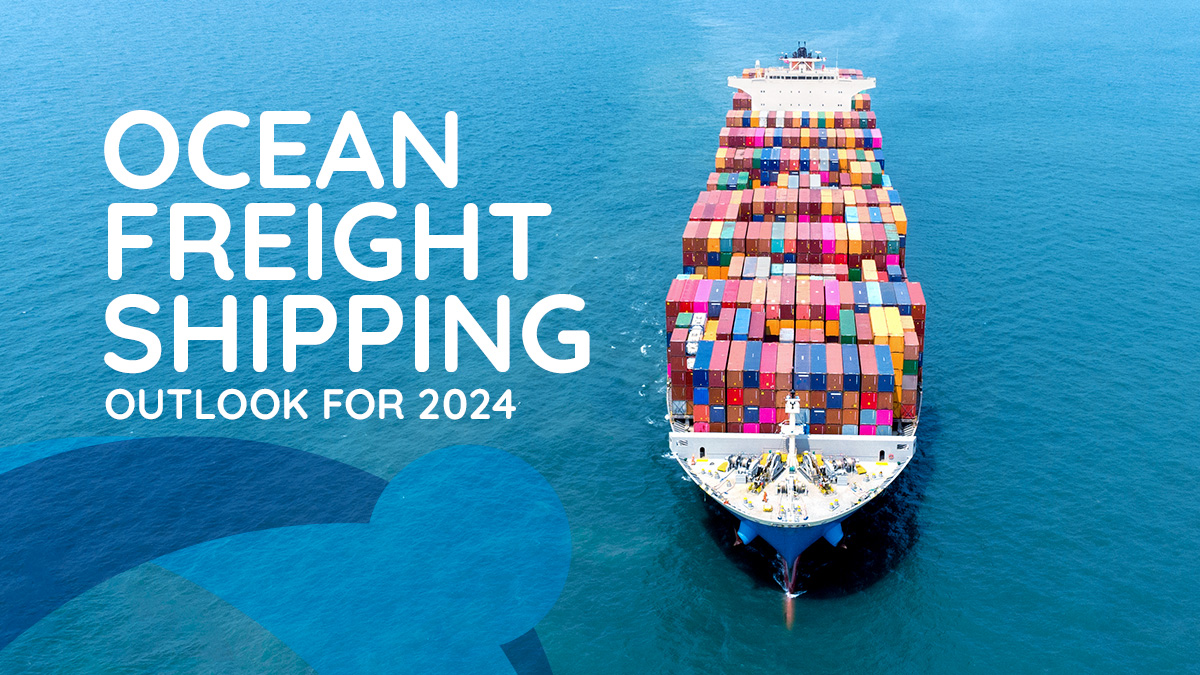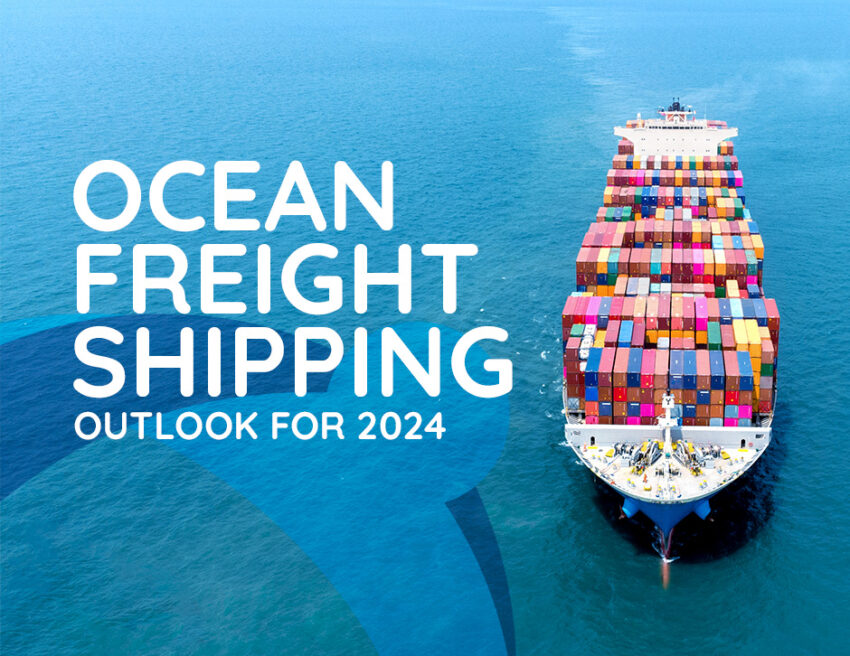In the volatile ocean freight shipping, the years since 2020 have been a tumultuous journey. Moreover, with the remarkable rate hikes of early 2022 and the unprecedentedly low prices witnessed in 2023, sea freight forwarders are keen to unravel the uncertainties that lie ahead in 2024. Will there be a resurgence for container vessels, or are additional challenges looming on the horizon? This blog will offer a glimpse into the perspectives offered by industry reports and expert opinions to explain the potential scenarios awaiting the sea freight market in the upcoming months.
Decreasing Demand and Surge in Capacity
In the ocean freight shipping industry, various dynamics are unfolding, including a decrease in freight demand alongside a surge in capacity. According to the global shipping association BIMCO, there is a projected modest increase of 3% to 4% in global container volumes for 2024. Concurrently, the global ocean fleet is anticipated to grow significantly by 7.8%, reaching an unprecedented 2.7 million TEU.

This scenario poses heightened competition for freight forwarders. With potential shifts in customer loyalty, sea freight forwarders must put in more efforts to distinguish themselves in the market. Strategies centered around exceptional customer service and the introduction of value-added services become imperative in this scenario. Operational efficiency also takes precedence, serving as a critical lever to maximize profitability in the face of challenging market conditions.
The ongoing competition among carriers for a diminishing pool of cargo is expected to exert continuous pressure on rates. Therefore, independent freight forwarders must strike a balance between offering competitive pricing and maintaining their financial health in this environment. The path forward necessitates adaptability and resilience, as industry players strive to distinguish themselves, improve operational efficiencies, and navigate the evolving dynamics of supply and demand in the transport and logistics sector.
Impact of Climate Change and an Unstable Geopolitical Scenario
As sea freight forwarders reflect on the transformative trends of 2023, black swan events emerge as significant disruptors. However, with the onset of 2024, attention is shifting from the unpredictability of random occurrences to the looming and disruptive forces of climate change and geopolitical unrest. These factors carry the potential to impact resource supplies, disrupt transportation routes, interrupt production processes, and escalate costs throughout the supply chain.
Research indicates a troubling increase in the frequency of natural disasters, including droughts, hurricanes, and wildfires. In 2023, for example, low water levels significantly impeded container traffic through vital waterways such as the Panama Canal, the Yangtze River in China, and the Rhine in inland Europe. Concurrently, global tensions and conflicts, both existing and emerging, pose a substantial threat to supply chain operations and investments.
In this intricate landscape, the ocean freight shipping industry stands at a crucial juncture, compelled to prioritize agility, flexibility, and visibility. The ability to anticipate challenges and swiftly navigate disruptions in the supply chain becomes paramount. The objective is clear – to flourish amid climate change and geopolitical uncertainties, ocean freight forwarders must adopt a proactive and adaptive approach, ensuring they are well-prepared to navigate through the uncertainties that lie ahead.
Low Sea Freight Shipping Rates
The container shipping industry faces less-than-optimistic prospects, with many analysts not foreseeing a significant upturn in rates. According to Container xChange‘s 2024 report, the forecast of “reduced demand and oversupply” could trigger intense competition, reduced profits, and potential mergers and acquisitions. BIMCO’s projection aligns with this, anticipating continued weakening in 2024 and 2025, driven by the forecasted 8.4% annual growth in supply outpacing demand.
Simon Heaney, Senior Manager of Container Research at Drewry, emphasized that demand is expected to remain relatively stagnant in the upcoming year, with global port throughput predicted to grow by only around 2%. In contrast, the fleet is projected to expand three times faster, exacerbating the market’s overcapacity. The consequence? Record-low freight rates, exerting significant downward pressure on the industry.
UPS echoes this sentiment, highlighting the Drewry Supply/Demand Index forecast for 2024, which stands at 74.3 – the lowest ever reported. This index indicates that supply is surpassing demand, contributing to the prevailing low-rate levels in the industry.
Increasing Use of Smart Containers
The integration of smart containers is actively progressing, but the widespread adoption of this transformative technology encounters a formidable obstacle – the substantial investment it demands. In a conservative projection spanning five years, it appears improbable that smart containers will dominate the shipping industry. However, experts anticipate a tipping point in the coming year, where the compelling advantages of smart containers will become apparent to all stakeholders, including regulators and customs bodies.
More Focus on Sustainability
A significant paradigm shift is underway, with businesses increasingly committing to enhancing the sustainability of their supply chains. Findings from the world’s largest CEO study on sustainability, conducted by the United Nations Global Compact and Accenture, reveal that nearly half of CEOs now view supply chain responsibility as an integral component of their sustainability strategy. The spotlight is now on whether this momentum can be sustained in the face of challenges posed by the business environment.
A key question on the horizon is the willingness of customers to bear the added costs associated with sustainable logistics. The success of sustainable initiatives hinges on consumer acceptance and the broader industry’s ability to communicate the value of eco-friendly practices. Additionally, the role of freight forwarders becomes pivotal – will they prioritize collaboration with carriers and agents dedicated to advancing sustainability, thus catalyzing positive change throughout the supply chain?
As we embark on 2024, the container shipping industry finds itself at a crossroads, tasked with not only meeting regulatory requirements but also navigating the complex dynamics of consumer behaviour and business partnerships. The choices made in this pivotal year will shape the trajectory of sustainability in the transport and logistics sector, influencing not only environmental impact but also the resilience and long-term viability of businesses in an evolving global landscape.
Drive to Digitize Container Shipping Operations
In a significant step towards modernization and collaboration, the Digital Container Shipping Association (DCSA), a Dutch non-profit comprising nine major carriers, including industry giants like Maersk, MSC, Hapag-Lloyd, and Yang Ming, has successfully rallied its members to standardize electronic bills of lading (eBL). While the process faced challenges, and full compliance is slated for 2030, the message for supply chain leaders dealing with complex issues such as Scope 3 carbon accounting is resounding – embrace industry cooperation and move forward.
Moreover, a wave of platforms are emerging, each built on standards facilitating interoperability. Looking ahead, a groundbreaking shift is expected within the next five years: the seamless, automatic exchange of digital bills of lading between platforms through Application Programming Interfaces (APIs). This vision marks a departure from the current landscape where data exchange and collaboration often require manual interventions and intricate integrations. The move towards interoperability is a strategic response to the growing complexity of global supply chains, aiming for streamlined, efficient, and interconnected systems.
The emergence of technology platforms operating on shared standards is positioned to unlock new levels of efficiency and collaboration within the industry.


